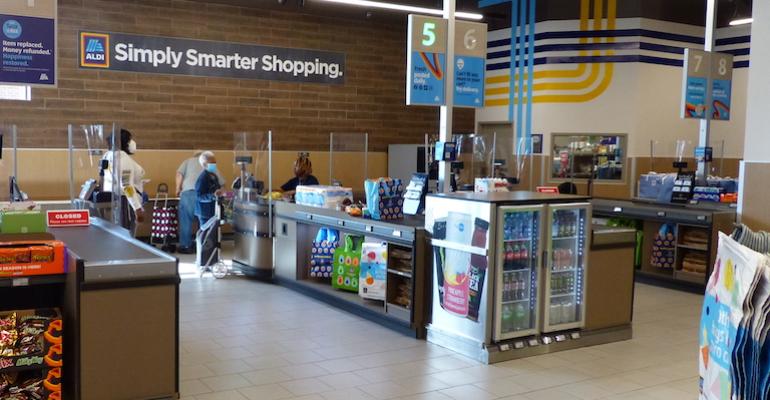Aldi gave a firsthand look at its low-price formula in a tour of its year-old store on Flatbush Avenue in the New York City borough of Brooklyn.
Scott Patton, vice president of national buying at Aldi U.S., explained how the Batavia, Ill.-based chain offers a curated selection of high-quality, private-label products in a compact store format with a simplified shopping experience that eschews promotional frills, enabling it to draw customers with hard-to-match, everyday-low prices.
That has been especially appealing in the current inflationary environment for food shoppers.
“We’ve seen more customers come to Aldi to save money,” Patton said at the Brooklyn store, located at 1628 Flatbush Ave., adjacent to Brooklyn College. “One thing I’ve recognized is that the cook-at-home [trend] that started during the pandemic seems to have stayed a while. So we’re seeing bigger baskets and people buying more products because eating out is so expensive. More customers are coming to our stores and purchasing full meals.”
Though not disclosing specific numbers, Patton said Aldi has seen double-digit sales growth over the past year. The retailer, with about 2,200 stores in 38 states, also reported that 1 million new households are now shopping its stores.
Over the last five years, Aldi’s fresh fruit and vegetable sales have risen 70%, fueled in part by a 20% expansion of its assortment, namely the addition of more organic items. Meat and seafood sales have doubled in that time frame — including a 77% jump in organic meat sales this year — even though Aldi stores don’t operate full-service meat and seafood counters.
Aldi’s store operations and format provide a number of ways for the company to pass on savings to customers. For example, in the Brooklyn store tour, Patton noted that simple decisions such as not having associates stack produce or man sampling stations save time and money, which ultimately is reflected in pricing. The smaller-footprint stores, too, don’t cost as much to operate, and Aldi said it “strategically stocks” only the items it knows that customers want.
Other avenues for more efficient operations and savings include the following:
• Produce and packaged goods are displayed in the crates and boxes they arrive in, cutting the time needed to stock shelves.
• Multiple barcodes are printed on Aldi product packaging for faster scanning at checkout.
• Store hours are limited to the most popular shopping times.
• To use a shopping cart, customers must insert a quarter to release a chain lock. They get the quarter back when returning the cart. This system means associates don’t have to collect carts in the parking lot.
• No background music is played in stores, so Aldi doesn’t have to pay licensing fees.
Among consumers, perhaps the best-known way that Aldi serves up savings is its primarily private-label selection, which accounts for 90% of items on its shelves. That approach gives the retailer more control over everything from ingredients to packaging, enabling it to identify the most efficient options and perform more rigorous quality-testing.
Aldi said one in three of its own brands is award-winning, and the company provides its “Twice as Nice Guarantee,” in which shoppers not fully satisfied with a product will receive a replacement and a refund. The private-label assortment also includes exclusive labels sourced directly from vineyards in Napa Valley, Champagne and Italy, a rotating selection of gourmet cheese and what the company called one of the largest selections of store-brand vegan milks, as well as traditional, organic and grass-fed milk and cultured dairy products.
“We’ve really invested in quality so we can get the repeat purchase,” Patton said. “That’s why we see consumers coming back and coming back, because not only are they saving money, but when they try the product, they really like it.”





